Melanie Manchot
Video installation and photographs by Melanie Manchot
The work of Melanie Manchot articulates acute studies of the relations between the individual and the collective. How is a community created? What is a community? An individual? What tensions are played out between public and personal space? (...)
These works are developed out of encounters, out of random or circumstantial communities that the artist, Melanie Manchot, orchestrates and stages. Programmed or improvised, these observed or carefully constructed situations leave a space for action by the Other, by the models, in the construction of the images."
Frank Lamy, MAC VAL, in: Exh. Cat. "Open Ended Now", 2018
"There is an additional aspect to her works, namely that, irrespective of the subject matter, they always have an independent formal or almost graphic quality. Colour, proportion, lines, expanses - the manner in which she engages with the media of film and photography opens up avenues for fully comprehending her work. Documentation and fiction combine with each other, discursive and formal investigations find multi-layered expression."
Hans-Joachim Gögl, INN SITU, Exh. Cat. "Melanie Manchot. Mountainworks (Montafon)", 2019
These works are developed out of encounters, out of random or circumstantial communities that the artist, Melanie Manchot, orchestrates and stages. Programmed or improvised, these observed or carefully constructed situations leave a space for action by the Other, by the models, in the construction of the images."
Frank Lamy, MAC VAL, in: Exh. Cat. "Open Ended Now", 2018
"There is an additional aspect to her works, namely that, irrespective of the subject matter, they always have an independent formal or almost graphic quality. Colour, proportion, lines, expanses - the manner in which she engages with the media of film and photography opens up avenues for fully comprehending her work. Documentation and fiction combine with each other, discursive and formal investigations find multi-layered expression."
Hans-Joachim Gögl, INN SITU, Exh. Cat. "Melanie Manchot. Mountainworks (Montafon)", 2019
Exhibition Work/Series

Alpine Diskomiks, 2019 (Detail)
Alpine Diskomiks, 2019
50 vinyl records begin to play automatically, starting in the order of the length of their first track, until all 50 records play simultaneously.
50 vinyl records begin to play automatically, starting in the order of the length of their first track, until all 50 records play simultaneously.
_Still2-web.jpg)
Still from Cornered Star, 2018
Cornered Star, 2018
The post-industrial city of Marl in Germany carries the scars of the economic depression that followed the fall of the mining industry. City squares are filled with public sculptures and bear witness of the past growth of the town. In the video Cornered Star a horse stands alone on the main city square. Early morning lights progressively illuminate the brutalist concrete architecture around. The horse is almost static, with very little movements, but in spite of his relative fixity, it remains the only source of life present in this deserted urban environment. The work looks at the archetypical forms of equestrian public sculptures and more broadly questions the use, codes and authority of public space artwork.
(Melanie Manchot)
The post-industrial city of Marl in Germany carries the scars of the economic depression that followed the fall of the mining industry. City squares are filled with public sculptures and bear witness of the past growth of the town. In the video Cornered Star a horse stands alone on the main city square. Early morning lights progressively illuminate the brutalist concrete architecture around. The horse is almost static, with very little movements, but in spite of his relative fixity, it remains the only source of life present in this deserted urban environment. The work looks at the archetypical forms of equestrian public sculptures and more broadly questions the use, codes and authority of public space artwork.
(Melanie Manchot)
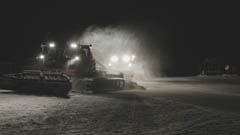
Still from Out of Bounds, 2016
Out of Bounds, 2016
Out of Bounds was made in the alpine landscape of Engelberg in Switzerland. Manchot accompanied two alpine rescue service teams on their daily work routine.
Staged as two separate large-scale projections, Out of Bounds follows the unseen labour of alpine workers in Engelberg as they perform the routine daily tasks that allow the winter sports industry to function. In sequences of mesmerising, endless choreography played out on the snowy mountain slopes, one team arises early to detonate controlled avalanches after fresh snow falls, and the other, a group of piste-bully drivers, flattens and compresses the mountain snow every night as if with an enormous iron. The films reflect Manchot’s long fascination with the historic shift in the perceptions of mountains, initially as horrifying, fearful places to the aesthetic appreciations of the Sublime, and now our contemporary desires for playgrounds of leisure and activity.
Out of Bounds was made in the alpine landscape of Engelberg in Switzerland. Manchot accompanied two alpine rescue service teams on their daily work routine.
Staged as two separate large-scale projections, Out of Bounds follows the unseen labour of alpine workers in Engelberg as they perform the routine daily tasks that allow the winter sports industry to function. In sequences of mesmerising, endless choreography played out on the snowy mountain slopes, one team arises early to detonate controlled avalanches after fresh snow falls, and the other, a group of piste-bully drivers, flattens and compresses the mountain snow every night as if with an enormous iron. The films reflect Manchot’s long fascination with the historic shift in the perceptions of mountains, initially as horrifying, fearful places to the aesthetic appreciations of the Sublime, and now our contemporary desires for playgrounds of leisure and activity.
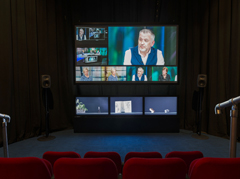
installation view of The Gift, 2015
The Gift , 2015
In the television studio of financial data and media organisation Bloomberg, a roundtable debate set up by artist Melanie Manchot is in progress. On a conveyor belt in front of them an assortment of objects move past - the tools and materials of the gardeners, musicians and tailors who work in the nearby City of London.
Under discussion is the role and significance of material culture in contemporary life, contrasting the unexpected occupations, and the hidden labour and objects of the City with the intense abstractions of Square Mile trading.
The Gift is an installation comprising a four-channel video, photography and a set of objects on plinths by Manchot.
In the television studio of financial data and media organisation Bloomberg, a roundtable debate set up by artist Melanie Manchot is in progress. On a conveyor belt in front of them an assortment of objects move past - the tools and materials of the gardeners, musicians and tailors who work in the nearby City of London.
Under discussion is the role and significance of material culture in contemporary life, contrasting the unexpected occupations, and the hidden labour and objects of the City with the intense abstractions of Square Mile trading.
The Gift is an installation comprising a four-channel video, photography and a set of objects on plinths by Manchot.
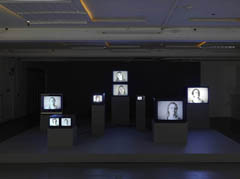
exhibition view 11/18, 2015
11/18 (2015)
Produced from 1998 until 2015, Manchot's video installation 11/18 is composed of edited footage collected from filming the same girl every month for the duration of one minute, recording her countenance between the ages of eleven and eighteen. On analogue Super8 filmstock the portraits fade in and out, displaying the changes that Manchot's subject has gone through, as her appearance and ways of relating to the camera alters. Manchot's subject responds to the camera, as if she is responding to someone familiar and to something uncanny. 11/18, thus emerges as a quest for identity and character, whilst pronouncing its inexplicable and ever-changing nature.
Interview about Melanie Manchots work "11/18" in i-D Magazine.
artist talk between Caroline von Grone and Melanie Manchot
Produced from 1998 until 2015, Manchot's video installation 11/18 is composed of edited footage collected from filming the same girl every month for the duration of one minute, recording her countenance between the ages of eleven and eighteen. On analogue Super8 filmstock the portraits fade in and out, displaying the changes that Manchot's subject has gone through, as her appearance and ways of relating to the camera alters. Manchot's subject responds to the camera, as if she is responding to someone familiar and to something uncanny. 11/18, thus emerges as a quest for identity and character, whilst pronouncing its inexplicable and ever-changing nature.
Interview about Melanie Manchots work "11/18" in i-D Magazine.
artist talk between Caroline von Grone and Melanie Manchot
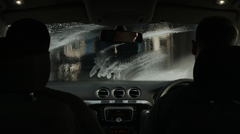
Still from Twelve, 2015
Twelve (2015), 2012
Over the last two years Manchot has worked in dialogue with twelve people in recent recovery from substance misuse, in rehabilitation communities in Liverpool, Oxford and London. Twelve is directly informed by their personal written and oral testimonies, creative conceptions, and performances within final works. Single sequences are shot as continuous takes, referencing iconic scenes from the films of Michael Haneke, Gus Van Sant, Bela Tarr and Chantal Akerman – a ferry journey across the Mersey, a darkened room looking out on to an early morning street, a car wash, the cutting of daisies with small scissors, the obsessive cleaning of a floor – providing the framework for reflections on remembered incidents and states of mind. Twelve employs a diversity of cinematic technique and tropes adapted by Manchot to reveal the complex and non-linear nature of recovery.
Over the last two years Manchot has worked in dialogue with twelve people in recent recovery from substance misuse, in rehabilitation communities in Liverpool, Oxford and London. Twelve is directly informed by their personal written and oral testimonies, creative conceptions, and performances within final works. Single sequences are shot as continuous takes, referencing iconic scenes from the films of Michael Haneke, Gus Van Sant, Bela Tarr and Chantal Akerman – a ferry journey across the Mersey, a darkened room looking out on to an early morning street, a car wash, the cutting of daisies with small scissors, the obsessive cleaning of a floor – providing the framework for reflections on remembered incidents and states of mind. Twelve employs a diversity of cinematic technique and tropes adapted by Manchot to reveal the complex and non-linear nature of recovery.

The Continuous Still, 2012
The Continuous Still (2012), series of photographs as public billboards
The Continuous Still series were produced as part of a commission from CONTACT Photography Festival in Toronto. Manchot worked with the Distillery’s rich and varied photographic archive to create a new series of images, each one displayed alongside the historic photograph it refers to. Taking its title from an image in the archive, The Continuous Still presents portraits of large and smaller groups (e.g., the Distillery’s staff or management, in the past and present day) and an iconic bird’s-eye view of the site. By creating a series of portraits of the Distillery’s working population, the artist investigates processes of identification in relation to labour, location, and community. When presented in combination with their archival precedents, the images examine the politics of regeneration and its effects on communities.
The Continuous Still series were produced as part of a commission from CONTACT Photography Festival in Toronto. Manchot worked with the Distillery’s rich and varied photographic archive to create a new series of images, each one displayed alongside the historic photograph it refers to. Taking its title from an image in the archive, The Continuous Still presents portraits of large and smaller groups (e.g., the Distillery’s staff or management, in the past and present day) and an iconic bird’s-eye view of the site. By creating a series of portraits of the Distillery’s working population, the artist investigates processes of identification in relation to labour, location, and community. When presented in combination with their archival precedents, the images examine the politics of regeneration and its effects on communities.
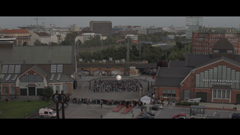
still from Walk (Square), 2011
Walk (Square) (2011), Single Screen, HD, 20'40''
Walking en masse, whether it be in processions, parades, pilgrimage, carnival, protest marches and demonstration form the starting point for this new videowork made with 1000 Hamburg kids. Drawn into the centre of the city from all directions, with art as the 'pied piper', the work refers to current socio-political situations of protest. It questions the way in which the act of walking, of traversing the public space of our cities constitutes a 'form of speech'. On the square in front of the museum the kids perform a simple walking choreography, based on Bruce Nauman's 'Walking the square in an exaggerated manner', creating a shimmering form of movement, that briefly produces a moment of collectivity and visual coherence before breaking apart.
Walking en masse, whether it be in processions, parades, pilgrimage, carnival, protest marches and demonstration form the starting point for this new videowork made with 1000 Hamburg kids. Drawn into the centre of the city from all directions, with art as the 'pied piper', the work refers to current socio-political situations of protest. It questions the way in which the act of walking, of traversing the public space of our cities constitutes a 'form of speech'. On the square in front of the museum the kids perform a simple walking choreography, based on Bruce Nauman's 'Walking the square in an exaggerated manner', creating a shimmering form of movement, that briefly produces a moment of collectivity and visual coherence before breaking apart.
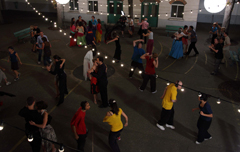
still from Dance (All Night, Paris), 2011
Dance (All Night, Paris) (2011), Single Screen Video, HD
The Continuous Still series were produced as part of a commission from CONTACT Photography Festival in Toronto. Manchot worked with the Distillery’s rich and varied photographic archive to create a new series of images, each one displayed alongside the historic photograph it refers to. Taking its title from an image in the archive, The Continuous Still presents portraits of large and smaller groups (e.g., the Distillery’s staff or management, in the past and present day) and an iconic bird’s-eye view of the site. By creating a series of portraits of the Distillery’s working population, the artist investigates processes of identification in relation to labour, location, and community. When presented in combination with their archival precedents, the images examine the politics of regeneration and its effects on communities.
The Continuous Still series were produced as part of a commission from CONTACT Photography Festival in Toronto. Manchot worked with the Distillery’s rich and varied photographic archive to create a new series of images, each one displayed alongside the historic photograph it refers to. Taking its title from an image in the archive, The Continuous Still presents portraits of large and smaller groups (e.g., the Distillery’s staff or management, in the past and present day) and an iconic bird’s-eye view of the site. By creating a series of portraits of the Distillery’s working population, the artist investigates processes of identification in relation to labour, location, and community. When presented in combination with their archival precedents, the images examine the politics of regeneration and its effects on communities.
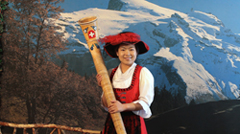
Photograph from the installation Perfect Mountain
Perfect Mountain, 2011
The work Perfect Mountain consists of a one-channel-video as well as an installation of 30 photographs. Both deal with masstourism on an alpine glacier. Tourists from all over the world guise as alpine farmers to get photographed in front of a photo-wallpaper of the very mountain they are standing. While the video observes the seemingly endless streams of visitors, the photographs in the installation are the very ones taken for the visitors and which are subsequently distributed as souvenirs around the globe and into the homes. "Perfect Mountain questions notions of an ideal, a search for perfection both of experience and its representation through photography."
- Melanie Manchot
The work Perfect Mountain consists of a one-channel-video as well as an installation of 30 photographs. Both deal with masstourism on an alpine glacier. Tourists from all over the world guise as alpine farmers to get photographed in front of a photo-wallpaper of the very mountain they are standing. While the video observes the seemingly endless streams of visitors, the photographs in the installation are the very ones taken for the visitors and which are subsequently distributed as souvenirs around the globe and into the homes. "Perfect Mountain questions notions of an ideal, a search for perfection both of experience and its representation through photography."
- Melanie Manchot
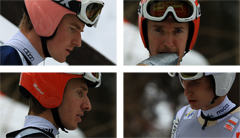
Stills from LEAP, 2011, Multi-channel-video-installation
LEAP - After The Great Ecstasy (2011)
Through a series of distinct sequences, LEAP observes a range of physical and psychological moments in the quest for a moment of perfection. Based around an annual worldcup event and set on the world’s largest natural skijump the material for LEAP was filmed during December 2010 in the high alpine valley of Engelberg, Switzerland.
More information
Through a series of distinct sequences, LEAP observes a range of physical and psychological moments in the quest for a moment of perfection. Based around an annual worldcup event and set on the world’s largest natural skijump the material for LEAP was filmed during December 2010 in the high alpine valley of Engelberg, Switzerland.
More information
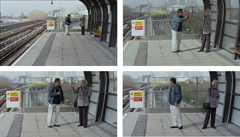
Stills from Spat, 2010
SPAT (2010)
The third piece in the trilogy of reconstructions, SPAT, focuses on an argument, taking place on a train platform between an elderly couple. The couple seems completely absorbed in their exchange, their gestures and facial expressions full of the passion of their respective points of view. As the camera approaches, gradually and hesitantly, it becomes increasingly quiet and we understand that the argument is carried out in sign language. Only by focusing on each other can the argument be articulated.
The third piece in the trilogy of reconstructions, SPAT, focuses on an argument, taking place on a train platform between an elderly couple. The couple seems completely absorbed in their exchange, their gestures and facial expressions full of the passion of their respective points of view. As the camera approaches, gradually and hesitantly, it becomes increasingly quiet and we understand that the argument is carried out in sign language. Only by focusing on each other can the argument be articulated.

Stills from Fight, 2010
FIGHT (2010)
FIGHT portrays a physical exchange, taking place between a young cycle courier and an aged Hells Angel. While absolutely different physically the two men are about equal in strength and the dynamic of the piece is built on their respective waves of aggression and withdrawal.
FIGHT portrays a physical exchange, taking place between a young cycle courier and an aged Hells Angel. While absolutely different physically the two men are about equal in strength and the dynamic of the piece is built on their respective waves of aggression and withdrawal.
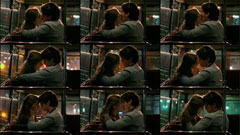
Stills from Kiss, 2009, 16 mm Film, 10 Min.
KISS (2009)
KISS concentrates on one of the gestures most intrinsic to cinematic language: the kiss. The work is filmed as an uncut 10 minute observation of a seemingly endless kiss on the topdeck of a London double-decker bus. Disengaged from their immediate environment, a young couple begins an intimate game of desire. Over the course of the film their exchange of embraces gathers intensity, growing increasingly passionate and demanding. The camera follows waves of desire, at times verging on pain and aggression then again full of joy and lightness.
KISS in the Théâtre du Châtelet in Paris on the occasion of the Nuit Blanche 2009
KISS, FIGHT and SPAT have been on view in the exhibition Do You See Me | Siehst Du Mich at Galerie m Bochum in 2010.
KISS concentrates on one of the gestures most intrinsic to cinematic language: the kiss. The work is filmed as an uncut 10 minute observation of a seemingly endless kiss on the topdeck of a London double-decker bus. Disengaged from their immediate environment, a young couple begins an intimate game of desire. Over the course of the film their exchange of embraces gathers intensity, growing increasingly passionate and demanding. The camera follows waves of desire, at times verging on pain and aggression then again full of joy and lightness.
KISS in the Théâtre du Châtelet in Paris on the occasion of the Nuit Blanche 2009
KISS, FIGHT and SPAT have been on view in the exhibition Do You See Me | Siehst Du Mich at Galerie m Bochum in 2010.
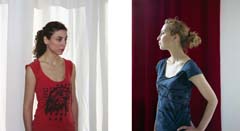
Double Portrait, Istanbul, 2009, C-Print
Doubleportrait (displaced), 2009
Based on the history of painted double portraits, this new set of diptychs aims to extend the performative process of portraiture through the relationship of two participants, displaced by migration.
To make this new series, Manchot photographed two people, one living in London and one in Istanbul, who in the first instance nominated each other as their ‘counterpart’ for the portrait. The work hence portrays a relationship between two people: family ties, friendship, romance - while at the same time portraying each individual in their respective homes.
In reference to the history of painted double portraiture the two images create visual links across the separation of each clearly defined image, and hence attempt to build a visual bridge between the two people – connected yet displaced.
More Information
Based on the history of painted double portraits, this new set of diptychs aims to extend the performative process of portraiture through the relationship of two participants, displaced by migration.
To make this new series, Manchot photographed two people, one living in London and one in Istanbul, who in the first instance nominated each other as their ‘counterpart’ for the portrait. The work hence portrays a relationship between two people: family ties, friendship, romance - while at the same time portraying each individual in their respective homes.
In reference to the history of painted double portraiture the two images create visual links across the separation of each clearly defined image, and hence attempt to build a visual bridge between the two people – connected yet displaced.
More Information

Celebration (2010)
Based on the rich history of public street celebrations in the UK and in London’s East End specifically, ‘Celebrations’ will be a new 16mm film using a whole East London residential street as its setting and involving its entire population as collaborators. My particular interest lies in investigating to what extent contemporary urban communities, characterised by an increasingly complex socio-cultural crossover within its population, can use ritual and ceremony to create a sense of place and identity. In this context, this project seeks to question how cities can still function as community sites for the development of collective memory and shared experience.
More information
Based on the rich history of public street celebrations in the UK and in London’s East End specifically, ‘Celebrations’ will be a new 16mm film using a whole East London residential street as its setting and involving its entire population as collaborators. My particular interest lies in investigating to what extent contemporary urban communities, characterised by an increasingly complex socio-cultural crossover within its population, can use ritual and ceremony to create a sense of place and identity. In this context, this project seeks to question how cities can still function as community sites for the development of collective memory and shared experience.
More information

Shave, video installation, Galerie m, 2007
Shave (2007)
Slowly, the camera orbits around the figure of a seated man, bare chested, who is being shaved by a barber. The central image of the video installation SHAVE is projected larger than life on the wall, the depicted body generating an extraordinary presence in the room. A recurrent splashing noise steers the viewer's gaze back to the center of the room, to the video of a bowl in which the used razor is being continually rinsed in synchrony with the projection. This action takes place on a monitor into which one peers from above, as if into the real bowl.
Further information on exhibition at Galerie m
Slowly, the camera orbits around the figure of a seated man, bare chested, who is being shaved by a barber. The central image of the video installation SHAVE is projected larger than life on the wall, the depicted body generating an extraordinary presence in the room. A recurrent splashing noise steers the viewer's gaze back to the center of the room, to the video of a bowl in which the used razor is being continually rinsed in synchrony with the projection. This action takes place on a monitor into which one peers from above, as if into the real bowl.
Further information on exhibition at Galerie m
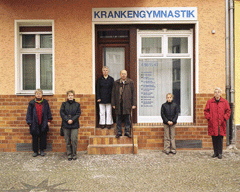
Neighbours (Berlin), 2005 / 06, C - Print
Neighbours (2006)
100 years ago there was a tradition of portraying citizens in front of their apartment houses - in Berlin, for example. Based on a small series of historical postcards, Melanie Manchot tracks down the places depicted and persuades the current residents to pose for group photos with their neighbors living under the same roof. The contrast between the historical and contemporary situations makes for the special impact of these portraits.
More pictures
100 years ago there was a tradition of portraying citizens in front of their apartment houses - in Berlin, for example. Based on a small series of historical postcards, Melanie Manchot tracks down the places depicted and persuades the current residents to pose for group photos with their neighbors living under the same roof. The contrast between the historical and contemporary situations makes for the special impact of these portraits.
More pictures
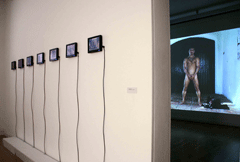
Security, 2005, video installation,
Haus am Waldsee, Berlin, 2006
Haus am Waldsee, Berlin, 2006
Security (2005)
This video installation consists of seven monitors and one projection and shows bouncers undressing in front of the discotheques they guard in Ibiza. Men whose job it is to judge people by their appearance and decide whether to let them in suddenly find the tables turned, with the spotlight on themselves, now their appearance under inspection. In the process of taking off their work clothes, these men go through a process of transformation allowing for moments of intimacy between the camera and its subjects.
More information
Security, 21'16''
This video installation consists of seven monitors and one projection and shows bouncers undressing in front of the discotheques they guard in Ibiza. Men whose job it is to judge people by their appearance and decide whether to let them in suddenly find the tables turned, with the spotlight on themselves, now their appearance under inspection. In the process of taking off their work clothes, these men go through a process of transformation allowing for moments of intimacy between the camera and its subjects.
More information
Security, 21'16''
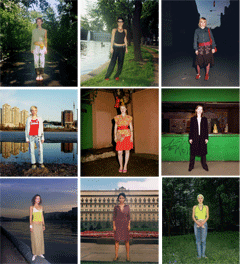
Moscow Girls, 2004, C - Prints, diasec
Moscow Girls (2004)
Alongside portraits of young Moscow women, this work also features recordings that Melanie Manchot made of their personal experiences upon the opening up of the East in 1991. These accounts "are like life confessions of love and happiness, betrayal and loneliness, and stand in contrast to the smoothness of the images that Manchot took of them." (Katja Blomberg, 2006)
More pictures
Alongside portraits of young Moscow women, this work also features recordings that Melanie Manchot made of their personal experiences upon the opening up of the East in 1991. These accounts "are like life confessions of love and happiness, betrayal and loneliness, and stand in contrast to the smoothness of the images that Manchot took of them." (Katja Blomberg, 2006)
More pictures
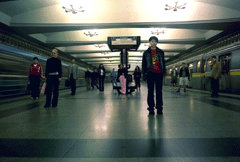
Groups + Locations, 2004, C - Print
Groups + Locations (2004)
For this project, which was carried out in Moscow, Melanie Manchot asked passers-by in public and semi-public places (e.g. railway stations and parks) if she might take a spontaneous photo of them in exactly the position in which she found them. The result is a set of unusual group portraits in which the anonymity and hectic pace of the public venue are momentarily erased. All images are taken in locations where people’s right to congregate is restricted and the taking of photographs prohibited.
For this project, which was carried out in Moscow, Melanie Manchot asked passers-by in public and semi-public places (e.g. railway stations and parks) if she might take a spontaneous photo of them in exactly the position in which she found them. The result is a set of unusual group portraits in which the anonymity and hectic pace of the public venue are momentarily erased. All images are taken in locations where people’s right to congregate is restricted and the taking of photographs prohibited.
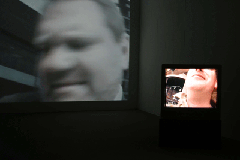
For a Moment Between Strangers, 2001
Videoinstallation
Videoinstallation
For a Moment Between Strangers (2001)
"Excuse me, could I interrupt you for just one second. I wonder whether you would give me a kiss." With this sentence, Melanie Manchot takes up contact with strangers in the street in New York, Los Angeles, London and Cologne, provoking the most diverse reactions, which she then records with a hidden camera.
More pictures
"Excuse me, could I interrupt you for just one second. I wonder whether you would give me a kiss." With this sentence, Melanie Manchot takes up contact with strangers in the street in New York, Los Angeles, London and Cologne, provoking the most diverse reactions, which she then records with a hidden camera.
More pictures
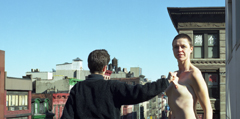
Gestures of Demarcation III, 2001
C-Prints
C-Prints
Gestures of Demarcation
The skin – lambent, holding light somewhere below its surface then sending the light back. A phenomenon of vision, questioning the coherence of inside/out, in which the interior always remains withheld from vision. These capacities of light, irreducible to the photographic, an echo, reverberations. Almost like looking through a backlit curtain. A trace of your presence before the camera can relocate you in that way also. A corporal ember distantiated from the environment, almost rendering the background down to two dimensions, emptying its volume, making it planar and cinematic.
more information
The skin – lambent, holding light somewhere below its surface then sending the light back. A phenomenon of vision, questioning the coherence of inside/out, in which the interior always remains withheld from vision. These capacities of light, irreducible to the photographic, an echo, reverberations. Almost like looking through a backlit curtain. A trace of your presence before the camera can relocate you in that way also. A corporal ember distantiated from the environment, almost rendering the background down to two dimensions, emptying its volume, making it planar and cinematic.
more information

Emma & Charlie, 2001, C - Prints
The Fontainebleau Series (2001)
This series consists of sets of 3 pictures, each showing two naked women in a bathtub. In the first image of these triptychs, one woman pinches the other’s nipple. The title of the series refers to a famous painting in the Louvre by an unknown artist who belonged to the Fontainebleau School. In the style of mannerism, it probably represents Gabrielle d'Estrées, the beloved of King Henry IV of France, together with another person, maybe her sister, the wife of Marschall de Balagny. The intimacy of private life interferes with a certain public space, and in the simultaneity of both nudity and mask there emerges a bizarre atmosphere.
Find more here
This series consists of sets of 3 pictures, each showing two naked women in a bathtub. In the first image of these triptychs, one woman pinches the other’s nipple. The title of the series refers to a famous painting in the Louvre by an unknown artist who belonged to the Fontainebleau School. In the style of mannerism, it probably represents Gabrielle d'Estrées, the beloved of King Henry IV of France, together with another person, maybe her sister, the wife of Marschall de Balagny. The intimacy of private life interferes with a certain public space, and in the simultaneity of both nudity and mask there emerges a bizarre atmosphere.
Find more here
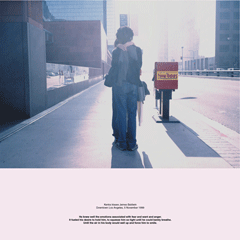
Kenka kisses James Baldwin Downtown
Los Angeles, 5. November 1999,
2000, Lambda Print
Los Angeles, 5. November 1999,
2000, Lambda Print
The L.A. Pictures (2000)
Not all of the couples agree to kiss in front of the camera and then write down whom they would most like to kiss – and why. Melanie Manchot joins photograph and text to create an independent, astonishing work.
Not all of the couples agree to kiss in front of the camera and then write down whom they would most like to kiss – and why. Melanie Manchot joins photograph and text to create an independent, astonishing work.
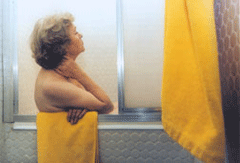
The shower, 1999, C - Print
Liminal Portraits (1999-2000)
In "Liminal Portraits" Melanie Manchot depicts her mother, but the way she chooses to do so exceeds all bounds of supposed intimacy. The images approach what we are familiar with from the world of advertising, without however losing themselves in superficialities.
In "Liminal Portraits" Melanie Manchot depicts her mother, but the way she chooses to do so exceeds all bounds of supposed intimacy. The images approach what we are familiar with from the world of advertising, without however losing themselves in superficialities.
Look at you loving me (1995-1998)
In the series „Look at you loving me“ Melanie Manchot works with her mother for the first time. She is portraited naked and pure. With this act-pictures Melanie Manchot wants to opened the viewers eyes for another ideal of beauty and criticises the present world of commerce.
More Information
In the series „Look at you loving me“ Melanie Manchot works with her mother for the first time. She is portraited naked and pure. With this act-pictures Melanie Manchot wants to opened the viewers eyes for another ideal of beauty and criticises the present world of commerce.
More Information
